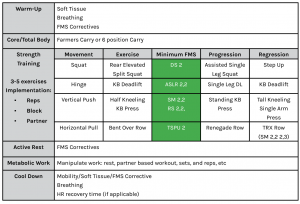Resources
Move Your way into Summer
Diversify Your Spring Training in the Great Outdoors with FMS
Written by Kyle Barrow Monday, March 25, 2019 FMS

It is no secret that physical activity continues to decline, particularly in the Western world. However, there is a growing movement of professionals and enthusiasts who are bucking this trend and taking to the great outdoors. Whether it is for a recreational activity or organized group exercise, outdoor training is gaining traction. With the season of warmer temps upon us, now is an optimal time to capitalize on the outdoor environment to not only motivate, but also facilitate exercise.
No matter the environment, meeting clients where they are, while also catering to their interests and strengths, is imperative. Many people are taking the initial step to improving their health and fitness and may not yet be ready for a strenuous exercise program. But how do you know? Setting a movement baseline with the Functional Movement Screen (FMS) and learning exactly where participants are is the best place to start. This is your opportunity — as the pro — to establish that your first priority is taking care of the people you train, while simultaneously meeting their needs and challenging them without causing unnecessary injury.
After establishing the baseline with an FMS, you can confidently create an individualized program to match your client or participants’ fitness goals in a group setting (or even one-on-one training). Arming yourself with participants’ movement profiles is key to your success as a competent professional and your clients’/exercise participants’ ability to achieve their goals.
When performing a FMS, it is important to determine the best environment for proper testing and set-up. And, if you have more than one kit, that’s even better for building efficiency into group screening. Screening should be conducted on a hard, flat surface (such as a sidewalk, concrete slab or parking lot) and participants should wear the shoes they normally wear for exercise. While ensuring participants are properly set-up, FMS professionals look for an acceptable FMS score (no pain, 1’s or major asymmetry).
Training individuals with a lower level of movement competency can be a challenge, but this is where your biggest opportunity comes into play. This is also when an individualized program takes center stage. It can be as simple as a few correctives done independently, as well as alternatives to certain activities when training with a group. Let the Screen guide your decisions here.
The workouts should be kept to a minimum, keeping them simple so you can cater your workout to everyone. Utilize fundamental movements such as the squat, hinge, push, pull and anti-rotational exercises and, based on the screen results, generate progression and regression exercises. Below is an example workout of how an FMS professional can create a variety of workouts based on screen results with minimal equipment needs.

Although outdoor training has its benefits, you still should be cautious and account for all participants. It’s not a one size fits all game anymore. Clients require (and, quite frankly, expect) individualization and progressive outcomes. The FMS System takes the guessing game out of program design and arms you with the tools to design creative programming, while also ensuring your clients are on the best path for sustainable health and longevity.